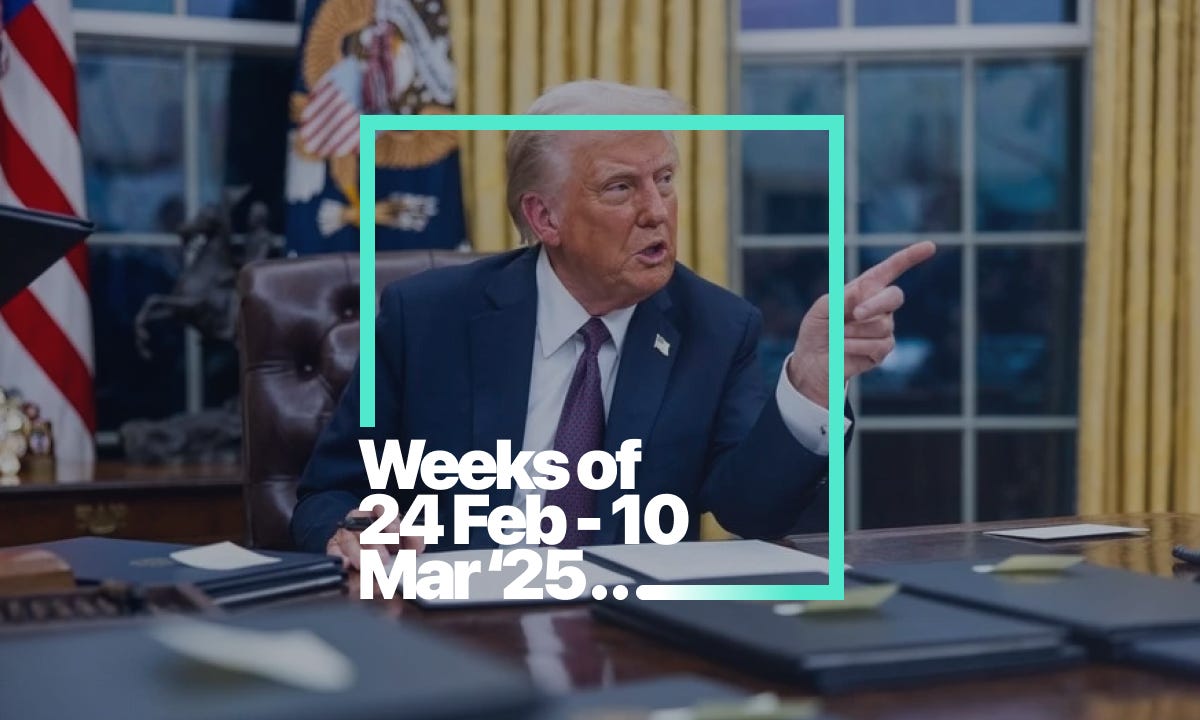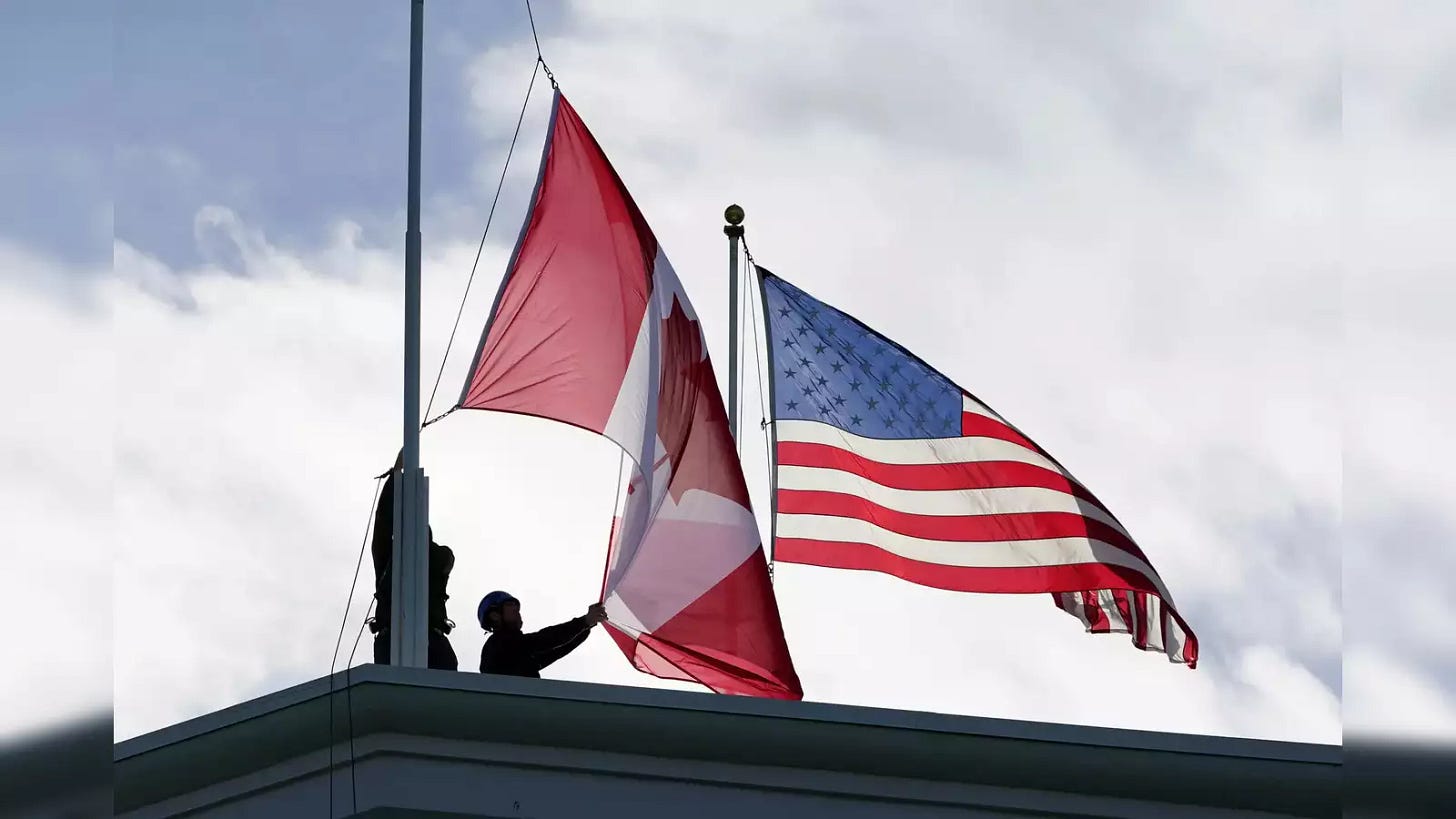Hello 👋 get a brew on because these are the top 3 emerging risks between February 24th, and March 10th, 2025…
Economic | At the crossroads of global commerce and geopolitical tension, a new narrative of international trade anxiety unfolds before us. The US administration has cast a wide net of tariffs across products from Mexico, Canada, and China, an action that reverberates through all sectors with ripples touching distant shores like Japan, Korea, and Australia.
We are witnessing the swift retaliation already choreographed by Canada and Mexico, with China joining this economic dance through targeted commodity tariffs and strategic export controls on critical minerals. The situation invites businesses into a moment of deep introspection about their place in this shifting landscape; are you directly exposed through existing trade flows, or indirectly vulnerable through the threads of your supply chain? In response, organisations are charting courses both immediate and long-term: exploring technical solutions like the 'first sale' rule and unbundling pricing components, navigating special customs programs as mid-term havens, and contemplating fundamental questions about where and how they source their goods.
New Zealand's move toward digital services taxes, for example further complicates this tableau, revealing how even nations at geographical remove are crafting responses to capture value from multinationals operating virtually within their borders. This moment calls for not just tactical adjustments but a philosophical reimagining of how businesses position themselves in an increasingly fragmented global marketplace. This week, we are pleased to share a longer form podcast with a discussion between EY's Matt Andrew and the New Zealand Trade & Enterprise. We dive into this developing situation as this week's main risk below. SourceGeopolitical | In the unfolding tensions between Taiwan and China, a new chapter has emerged that speaks volumes about the delicate geopolitical balance in the region. Taiwan has detained a Chinese-linked cargo vessel, suspecting its involvement in damaging two crucial undersea internet cables near the Taiwanese islands of Matsu early 2025. The detention of the vessel - a gravel ship registered in Sierra Leone but with significant Chinese connections - represents more than just a technical incident, it embodies the deeper narrative of Taiwan's ongoing struggle to maintain its sovereignty in the shadow of Beijing's influence.
Authorities took decisive action after reviewing surveillance footage that placed the vessel near both cable ruptures on February 2nd and February 8th, incidents that severely disrupted communications for the 14,000 residents of Matsu and required weeks of repair work by technicians. This maritime confrontation reflects the broader tensions in the Taiwan Strait, where infrastructure vulnerability intersects with questions of national security, and where even something as seemingly mundane as a gravel ship can become entangled in the complex web of cross-strait relations.Businesses should consider the risk of escalating cyber and physical infrastructure disruptions due to increased geopolitical tensions, potentially leading to communication blackouts and supply chain interruptions. This could force businesses to invest in redundant systems and alternative communication pathways, while also facing increased regulatory scrutiny and potential trade restrictions. Source
Economic | Findings from multiple sources suggest that the five major GenAI labs that produce our most popular Large Language Models (like ChatGPT) are not profitable and that the costs to run these companies is no longer sustainable. ChatGPT's operational costs in 2024 was $9 billion with a reported loss of $5 billion. Similarly, the fees these LLMs charge for API access, token usage, or "pro" subscriptions are not providing enough capital for any of the labs to begin to become profitable. Key players like Microsoft who are heavy investors in OpenAI (with a reported $13-14 billion invested up to 2023) appear to be recalibrating its AI strategy amid concerns about OpenAI's growing compute demands and uncertain profitability, evidenced by a significant 14% reduction in planned data centre capacity and paused expansion projects, possibly signalling diminished confidence in generative AI's immediate growth potential and financial sustainability.
Businesses with technical AI frameworks embedded deep in their operational infrastructure are most at risk. As the AI buzz continues to be pushed by those most heavily invested in the innovation, organisations may be left vulnerable to failing labs and systems that rely on solid APIs. In other words, now is the time to understand a fallback if connections to specific LLMs fail.
Our thoughts
At Unbreakable Ventures, we try to avoid political opinions as they rarely add value to the risk landscape. That said, geopolitical and economic policy invariably impact businesses. US President Donald Trump's recent tariffs have disrupted China, Canada, and Mexico, with unclear global consequences. But it is now obvious more countries are seeing the impact and opportunities of these tariffs.
In February, our team joined a discussion on the tariffs' wider implications for New Zealand businesses with EY's Global Transformation Lead and Head of Tax Policy from Hong Kong, Matt Andrew. While focused on New Zealand SMEs, the insights apply universally. Matt emphasised that all businesses face risk from these tariffs, not just those in the targeted countries. Understanding your product's component origins and navigating vague frameworks for determining non-Chinese, Mexican, or Canadian manufacture is crucial. Listen to our feature length podcast for Matt's fascinating, well-researched perspective on the situation and EY's preparation recommendations above.
Meanwhile, Taiwan has apprehended a Chinese vessel in another subsea cable incident, coinciding with Meta's announcement of "Project Waterworth", a 50,000km subsea cable connecting the US, India, Brazil, South Africa, and other key regions. While increased cable numbers naturally raise damage risks, this specific Chinese-Taiwanese incident carries significant geopolitical weight. We're monitoring this closely to check for any escalations. But as tech juggernauts like Meta continue to increase the subsea infrastructure (and even low orbit solutions), we must strongly consider a mitigation option.
Finally, OpenAI spent at least $2.25 to make $1 in 2024, a ratio reflecting the broader GenAI landscape and suggesting an overvalued, overhyped market ripe for correction. If this occurs, many businesses will feel profound impacts. While GenAI will persist, (likely becoming an enterprise commodity controlled by top players like Google and Microsoft) inexpensive API access may disappear within two years. We suggest evaluating how deeply AI is embedded in your operations and organisational fabric. This is an investigation we are looking forward to sharing a deeper insight on soon.
Want to discuss how these risks might effect your business?
Book 30 minutes with us, free ↗
POTUS doesn't like your foreign parts either.
Category: Economic
Review our report’s terminology here ↗
In summary: We are witnessing a fascinating evolution of how national identity is assigned to products crossing borders. For businesses embracing the global marketplace, the traditional comfort of a "Home made" label now faces a deeper scrutiny, one that peers into the very DNA of their products. The U.S. administration, with its heightened awareness of supply chain geopolitics, now looks beyond surface-level appearances to examine whether a product has undergone sufficient "substantial transformation" on home soil to truly claim it's unique identity against the origin of its component parts. This philosophical question of transformation echoes ancient paradoxes: when does a ship repaired plank by plank become an entirely new vessel? Similarly, at what threshold (perhaps 40% or 50% based on existing Free Trade Agreements) does a product with Chinese, Canadian, or Mexican components shed its origin story and become authentically unique to the supplier's country of origin?
The ripple effects of this examination extend through the invisible threads of global supply chains. A company might orchestrate a complex choreography of materials moving from China to Thailand to Australia before reaching American shores, yet find themselves unable to escape the gravitational pull of heavier tariffs. This scenario invites us to reflect on deeper questions about authenticity and identity in a world where few things are truly made in isolation. The physical journey of components (raw materials becoming parts, parts becoming products) mirrors our own transformative experiences, where we constantly integrate external influences while maintaining our core identity. For businesses navigating this landscape, the challenge becomes not just logistical but existential: understanding where their products truly come from and what substantial transformation truly means in both practical and philosophical terms. Where the impacts of tariffs are yet to be realised is outside of China, Mexico, and Canada. Soon, the world will see how the ripple effect of these tariffs will impact us all.
Sources:
Measles Outbreak– Feb. 21, 2025 | Texas Health and Human Services
Measles Sicken Nearly 100 in Texas and New Mexico | Wall Street Journal
Record-breaking measles outbreak plagues western Texas as cases spread to New Mexico | NY Post
The Guardian | Texas measles outbreak grows to 90 cases, worst level in 30 years
You should be concerned if…
Exporters with manufacturing, production, or processing in the United States and with heavy imports of inputs. These businesses may be significantly impacted if they are importing parts or raw materials from Mexico, China, or Canada. Such businesses should conduct an impact assessment and consider managing their supply chains and transfer pricing.
Exporters who manufacture or source goods in China, Canada, or Mexico, and then sell to the U.S. These businesses should assess the financial risks and potential costs associated with tariffs. They should also evaluate their pricing strategies and supply chain management.
Exporters who export to the U.S. from the local market, excluding China, will likely experience a lower impact.
These items are generic assumptions. We recommend considering your own unique risk landscape against your critical dependencies. If you don’t know what they are, get in touch.
Disruption Risk
Supplier / 3rd Party Negligence
Delays in receiving essential materials or services.
Breach of contract or financial losses due to negligence.
Resignation of Staff Members
Gaps in the workforce may lead to decreased efficiency.
Financial burden of finding and training replacements.
Inability to access buildings or systems, causing downtime.
Theft, Fraud, or Malice
Direct theft of money, assets, or intellectual property.
Loss of trust from customers and partners if fraud occurs.
Loss of critical assets may halt or delay business functions.
Preventative actions
Matt Andrew recommends several preventative actions to mitigate tariffs and their potential impact on businesses. These actions include:
Assessing the current situation
Determine if the business has a significant footprint in or geopolitical risk connected to countries subject to tariffs
Also determine if the business has a risk because it buys raw materials, parts, or manufactures in these jurisdictions, and then sells into the US.•
Short-term strategies
For businesses with connections to countries that have tariffs imposed
First sale rule Consider using the U.S. first sale rule for export planning to potentially lower landed costs
Unbundling Separate costs like royalty, service, and warranty from the product's landed cost to reduce the overall tariff base
Customs effective transfer pricing Adjust transfer prices to reduce the landed cost of goods
Medium-term strategies
Special supply chain and customs programs Utilise programs like duty drawback, bonded warehouses, or foreign trade zones to defer or potentially reduce duties
Longer-term strategies
Cost reduction Implement cost reduction strategies throughout the supply chain
Alternative sourcing and manufacturing Consider diversifying sourcing and manufacturing locations to reduce reliance on countries subject to tariffs
Pricing Strategies
Dissect pricing to identify cost reduction opportunities
Also consider using duty drawback schemes, bonded zones, and specific pricing strategies to manage risks and maintain competitiveness.•
Supply chain adjustments
Businesses should evaluate and potentially modify their supply chains to minimise the impact of tariffs
This could involve bringing raw material parts and components back to New Zealand for substantial transformation to reduce the risk.
Warehousing and inventory
Re-evaluate warehousing strategies
Consider moving from "stock to hold" to "just in time" delivery models, potentially using warehouses outside the U.S. but close by, such as in Puerto Rico or Panama. Bonded warehouses can also be used to delay the cash flow impact of tariffs.
Andrew also suggests businesses stay informed about changes to trade policies by monitoring resources such as the White House website for executive orders and fact sheets. Available expertise and resources can help develop these plans, including government agency resources, and experts in transfer pricing, supply chain, tax planning, and tariffs/country of origin.
Need support?
At Fixinc, we are passionate about helping people get through disasters. That’s why our team of Advisors bring you this resource free of charge. If you need help understanding these threats and building a plan against them, the same Advisors are here to help over a 30-minute online call. Once complete, if you like what was provided, you can choose to provide a donation or subscribe to Unreasonable Ventures to support this channel.


















